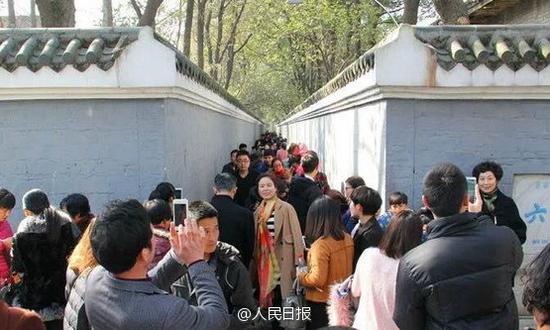
Visitors flocked to the Liuchi Lane during the Spring Festival. (Photo/Weibo)
People have never as interested in a small lane in Anhui province as they are nowadays.
During the week-long Spring Festival, which ended on Saturday, thousands overwhelmed Liuchi Lane in Tongcheng, a county-level city in East China's Anhui province.
For the visitors, a photo with the lane's name carved on a piece of stone would be enough to show off on their social media, because most would come up with a story being told for hundreds of years.
The lane, about 100-meters long east-west and 2-meters wide, is between two gray walls, both replicas of antique ones which had been on the site until being pulled down during the "cultural revolution" (1966-76).
In the name of the lane, "liu" means six while "chi" is a measure of length, the two words together means a length roughly equal to two meters nowadays.
To the south and north were mansions of two eminent households, the Zhang and Wu families, in the early Qing Dynasty (1644-1911).
The families both had male members who were high-level officials in the emperor's court or in other regions of the country.
The neighbors once quarreled over which of them could build a wall on the boundary of their domains. They took their claims to the then head of Tongcheng county but the official dared not offend either of the two families.
The Zhangs wrote to Zhang Ying, their most prominent family member and a trusted top official in Emperor Kangxi's court.
With a poem which is still very popular, Zhang refused to support his own family, while he proposed the latter step back one meter from the boundary.
It is said that the unexpected reply moved not only the Zhangs but also the Wus, both of whom gave up a meter of land and have since been in peaceful relationships.
"To the ordinary folk, the story is about how to get along with other people, while the authorities think it can also serve as a guideline for officials", said Wu Jianqiang, deputy director of the city government's publicity department.
It was reported that China's top graft-buster Wang Qishan, visited the site on Nov 15, 2014. Three days later, the ruling Party's Central Commission for Discipline Inspection, the top anti-graft body headed by Wang, released an article on its official website.
The article, about tolerance, morality, social order and qualities defining a good official caught eyes of many.
"Until the latest Spring Festival Gala Show the lane had never seen such popularity", said Zhang Yun, party chief of Shengli community which governs the area.
The gala, organized and broadcast by the country's central television, or CCTV, was reported to have been watched by 1.03 billion people.
Media surveys show one of the most popular items in the show on Feb 7 was a song about Liuchi Lane, sung by actress/singer Zhao Wei.
"It was the gala show that gave the lane the strongest push to its current popularity", said the community official.
Zhang, who claims to be a recorded descendant of Zhang Ying, said it was impossible to count how many visitors had flowed into the lane in the past week since it is free of tickets.
Zhang estimated that "at least 5,000 people visited the lane daily during Spring Festival which had never been seen before".
Zhang said only a small part of the Wu family's houses remain but a restoration plan is on the way.
The original houses of both families were taken by a hospital, which was built during the Korean War in the early 1950s.
During the "cultural revolution" most houses were pulled down and new buildings erected on the site.
"The local government made a plan to recover the original houses in 2011, while it will be by the end of 2016 that the planning and design works can be finished", said Duan Pengfei, chairman of the state-run Tong Cheng Culture & Tourism Investment and Development Co Ltd.
Duan said they had contacted Zhang Zeshi, the last occupant of the Zhangs' mansion who went to Taiwan in 1949.
Zhang drew a picture of the shapes and layout of the original houses.
The recovery project required investment of at least 290 million yuan ($44.5 million), according to Duan, while he thought it would be worthwhile since the lane and the two families were an important cultural symbol of China.


















































